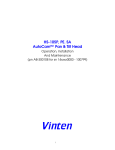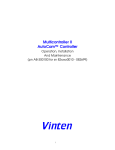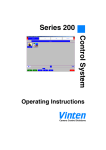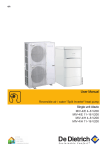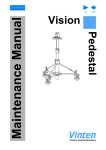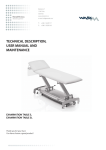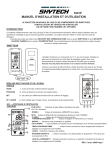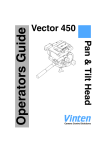Download SE-500 Elevation Unit
Transcript
SE-500 Elevation Unit AB-300134 Operators Guide AutoCam Vinten AutoCam™ SE-500 Servo Elevation Unit Installation and Operating Instructions Publication Part No. AB-300134 Issue 1 Copyright¤ Vinten Broadcast Limited 2003 All rights reserved throughout the world. No part of this document may be stored in a retrieval system, transmitted, copied or reproduced in any way including, but not limited to, photocopy, photograph, magnetic or other record without the prior agreement and permission in writing of Vinten Broadcast Limited. Vinten and AutoCam are registered trademarks of Vinten Broadcast Limited. Printed in Great Britain by DPS, Newmarket, Suffolk Foreword This manual provides Safety, Installation and Operating Instructions for the AutoCam SE-500 Servo Elevation Unit. WARNING!:Read the Safety Section on page 7 before using this elevation unit or attempting any adjustment or repair. It is recommended that this manual is read carefully and the illustrations studied prior to operating the elevation unit. Attention to the details contained herein will ensure that the elevation unit will operate efficiently with the minimum of attention over a long service life. To order spare parts or to obtain further information, application should be made to Vinten Broadcast Limited or to your local distributor, or visit our website at www.vinten.com. NOTE: Information contained in this document is subject to change. Vinten Broadcast Ltd reserves the right, without notice, to make changes in equipment design or performance as progress in engineering, manufacturing or technology may warrant. 3 4 Contents Page Foreword. . . . . . . . . . . . . . . . . . . . . . . . . . . . . . . . . . . . . . . . . . . . . . . . . . . . . . . . . . . . . . . . . . . . . . . . . . 3 Safety - Read This First! . . . . . . . . . . . . . . . . . . . . . . . . . . . . . . . . . . . . . . . . . . . . . . . . . . . . . . . . . . . . . 7 Warning symbols in this manual . . . . . . . . . . . . . . . . . . . . . . . . . . . . . . . . . . . . . . . . . . . . . . . . . . . 7 Safety issues . . . . . . . . . . . . . . . . . . . . . . . . . . . . . . . . . . . . . . . . . . . . . . . . . . . . . . . . . . . . . . . . . . . 8 Critical data . . . . . . . . . . . . . . . . . . . . . . . . . . . . . . . . . . . . . . . . . . . . . . . . . . . . . . . . . . . . . . . . . . . 11 Technical specification . . . . . . . . . . . . . . . . . . . . . . . . . . . . . . . . . . . . . . . . . . . . . . . . . . . . . . . . . . . . . 12 Technical support . . . . . . . . . . . . . . . . . . . . . . . . . . . . . . . . . . . . . . . . . . . . . . . . . . . . . . . . . . . . . . . . . 13 Manual outline . . . . . . . . . . . . . . . . . . . . . . . . . . . . . . . . . . . . . . . . . . . . . . . . . . . . . . . . . . . . . . . . . . . . 14 Chapter 1 - Introduction and Description Introduction . . . . . . . . . . . . . . . . . . . . . . . . . . . . . . . . . . . . . . . . . . . . . . . . . . . . . . . . . . . . . . . . . . . 17 Description. . . . . . . . . . . . . . . . . . . . . . . . . . . . . . . . . . . . . . . . . . . . . . . . . . . . . . . . . . . . . . . . . . . . 17 Base assembly . . . . . . . . . . . . . . . . . . . . . . . . . . . . . . . . . . . . . . . . . . . . . . . . . . . . . . . . . . . . . 17 Telescopic column . . . . . . . . . . . . . . . . . . . . . . . . . . . . . . . . . . . . . . . . . . . . . . . . . . . . . . . . . . 17 Control box . . . . . . . . . . . . . . . . . . . . . . . . . . . . . . . . . . . . . . . . . . . . . . . . . . . . . . . . . . . . . . . . 17 Power supply . . . . . . . . . . . . . . . . . . . . . . . . . . . . . . . . . . . . . . . . . . . . . . . . . . . . . . . . . . . . . . . 17 Chapter 2 - Installation Introduction . . . . . . . . . . . . . . . . . . . . . . . . . . . . . . . . . . . . . . . . . . . . . . . . . . . . . . . . . . . . . . . . . . . 20 Tools you will need . . . . . . . . . . . . . . . . . . . . . . . . . . . . . . . . . . . . . . . . . . . . . . . . . . . . . . . . . . . . . 20 Unpacking and assembling . . . . . . . . . . . . . . . . . . . . . . . . . . . . . . . . . . . . . . . . . . . . . . . . . . . . . . 21 Electrical installation. . . . . . . . . . . . . . . . . . . . . . . . . . . . . . . . . . . . . . . . . . . . . . . . . . . . . . . . . . . . 22 Chapter 3 - Operation Introduction . . . . . . . . . . . . . . . . . . . . . . . . . . . . . . . . . . . . . . . . . . . . . . . . . . . . . . . . . . . . . . . . . . . 26 Positioning the unit . . . . . . . . . . . . . . . . . . . . . . . . . . . . . . . . . . . . . . . . . . . . . . . . . . . . . . . . . . . . . 26 Powering up . . . . . . . . . . . . . . . . . . . . . . . . . . . . . . . . . . . . . . . . . . . . . . . . . . . . . . . . . . . . . . . . . . . 27 Powering down . . . . . . . . . . . . . . . . . . . . . . . . . . . . . . . . . . . . . . . . . . . . . . . . . . . . . . . . . . . . . . . . 27 Chapter 4 - Servicing General . . . . . . . . . . . . . . . . . . . . . . . . . . . . . . . . . . . . . . . . . . . . . . . . . . . . . . . . . . . . . . . . . . . . . . . 30 Cleaning . . . . . . . . . . . . . . . . . . . . . . . . . . . . . . . . . . . . . . . . . . . . . . . . . . . . . . . . . . . . . . . . . . . . . . 30 Routine checks . . . . . . . . . . . . . . . . . . . . . . . . . . . . . . . . . . . . . . . . . . . . . . . . . . . . . . . . . . . . . . . . 30 Repair . . . . . . . . . . . . . . . . . . . . . . . . . . . . . . . . . . . . . . . . . . . . . . . . . . . . . . . . . . . . . . . . . . . . . . . . 30 Index . . . . . . . . . . . . . . . . . . . . . . . . . . . . . . . . . . . . . . . . . . . . . . . . . . . . . . . . . . . . . . . . . . . . . . . . . . . . 31 5 6 Safety - Read This First! Warning symbols in this manual Where there is a risk of personal injury, injury to others, or damage to the elevation unit or associated equipment, comments appear, highlighted by the word WARNING! and supported by the warning triangle symbol. Warning symbols on the equipment Various colored safety labels are attached to the AutoCam equipment to alert you to hazardous situations. The labels and their meaning are described below. DANGER (with a red background) indicates an imminently hazardous situation which, if not avoided, will result in death or serious injury. WARNING (with an orange background) indicates a potentially hazardous situation which, if not avoided, could result in death or serious injury. CAUTION (with a yellow background) indicates a potentially hazardous situation which, if not avoided, may result in minor or moderate injury. CAUTION (with a yellow background, but without the Safety Alert symbol) indicates a potentially hazardous situation which, if not avoided, may result in property damage. 7 Safety issues Safety issues including important warnings, risks and related topics are covered in this section of the manual. It is very important that this information be available to all personnel who will work on or near the AutoCam equipment. Very important warnings WARNING!:To avoid personal injury, always exercise caution when working in the vicinity of energized pan/tilt heads and elevation units as they can start to move without any warning. WARNING!:Unless it is impossible, you should always de-energize the elevation unit and head before working on any part of the elevation unit, the head, the camera/lens, or any associated equipment. Customer responsibility It is the customer’s responsibility to ensure that the workplace is safe. In normal operation, the remote controlled elevation units, heads and payloads in an AutoCam system can move suddenly and without warning. Since audible warnings are out of the question in normal television applications, it is recommended that only trained personnel be allowed to work in the active areas where the remote controlled elevation units, heads and payloads are located. As part of the training, personnel must be made aware of the hazards of working in a robot environment, including the specific hazards listed below. The forces are sufficient to cause personal injury, or injury to others and therefore, caution is essential. Safe working environment WARNING!:Each of the remote controlled elevation units should be within the view of the operator of the AutoCam system at the controller. Before and during remote operation, the controller operator must verify visually that the active area is clear. If personnel are too close to one of the elevation units that is about to move, the operator can prevent the motion from starting, or stop the motion after it has started. If the direct line of sight is obstructed in your installation, it is recommended that one or more viewing cameras are installed to cover the active areas and allow the operator to view the entire workspace at all times. 8 Safe operating zone and elevation unit footprint WARNING!:The safe operating zone for personnel is a minimum of 3 feet (1m) outside of the elevation unit footprint. This allows time for the personnel to avoid a elevation unit that starts to move at its maximum speed of approximately 1 foot per second (0.3m per second). The elevation unit footprint is typically larger than the elevation unit base itself. In most installations, the teleprompter is the piece of equipment mounted on the head that protrudes the furthest beyond the base of the elevation unit. Or, it may be the manual control bars on the rear that protrude the furthest. The footprint must take into account the overhang of the teleprompter and/or manual control bars as the head pans around. If your operating practices require personnel to work less than 3 feet (1m) outside the elevation unit footprint, you must make sure that they are trained and are aware of the hazards of working in a robot environment, including the specific hazards listed below. The forces are sufficient to cause personal injury, or injury to others and therefore, caution is essential. Warning signs Warning signs should be displayed prominently in the workplace as a reminder to trained personnel, and a primary warning to untrained personnel and visitors. A typical sign might read: WARNING: Robotic Pedestals, Heads & Cameras Move Suddenly Without Warning 9 Elevation units and heads can start unexpectedly WARNING!:The hazards associated with robotic camera systems are only slightly different than those associated with operating a camera under conventional manual control. The speeds and camera weights are similar. The main difference is that with automation, the operator is normally not near the cameras, and it is more difficult to verify that the area is clear. For personnel working on or near the elevation units, they must be aware that the equipment can start moving unexpectedly. All personnel should be trained and aware of the hazards of robotic elevation units and heads, and the fact that they can move at any time. They must be trained on how far the elevation units, heads and payloads can move, the speeds involved, and the need to stay back an appropriate distance. Most adjustments to the camera and head, such as balancing and camera calibration, should be made with the system de-energized. However, if adjustments are absolutely necessary while the elevation unit and/or head is powered, they should only be made by trained technical personnel familiar with the AutoCam robotics system. They must understand that the elevation unit or head can move unexpectedly at any time, and they must position themselves so that any motion would not cause them personal harm. When the robotic heads move, the speeds involved are fairly slow. However, the equipment is still capable of generating sufficient force to cause injury. Therefore, it essential that you exercise caution. In particular, be aware that the teleprompter is usually the fastest swinging element. Any failure of the system could possibly cause one or more axes to move on their own, but the speeds and forces should not be noticeably greater than those encountered during normal use. Pinch points WARNING!:Particular care should be exercised around possible points where you could get pinched, such as the tilt cradle. Here, the forces can be somewhat greater, due to the short lever arm. Sharp edges WARNING!:If the lens, teleprompter or other camera attachments have sharp edges that could cause injury, make sure they are padded or protected. 10 Critical data Mass Servo elevation unit 32.6 kg (71.7 lb) Load Maximum payload 45.5 kg (100 lb) Power Supply Power supply 27 Vdc, 50 Watts 11 Technical specification Weight 32.6 kg (71.7 lb) Minimum height (to mounting face) 89.3 cm (35.1 in.) Maximum height (to mounting face) 128.3 cm (50.5 in.) Stroke 39 cm (15.4 in.) Transit doorway width 68 cm (26.8 in.) Maximum Payload 45.5 kg (100 lb) Maximum Velocity 24.4 mm/s (1 in./sec) Power Supply 12 27 Vdc, 50 Watts Technical support If you are based in North, South or Central America and need technical support on the AutoCam system, contact Vinten Inc. at: 709 Executive Blvd. Valley Cottage, NY 10989 USA Phone:1-888 4 VINTEN (1-888-484-6836) - Toll free in the U.S.A. +1 845-268-0100 Fax:+1 845-268-0113 Or, if you are based outside of North, South or Central America, contact Vinten Broadcast Limited at: Western Way Bury St. Edmunds Suffolk IP33 3TB ENGLAND Phone: +44 (0) 1284 752121 Fax: +44 (0) 1284 750560 13 Manual outline Safety - Read This First! covers important safety issues Chapter 1 - describes the SE-500 elevation unit Chapter 2 - contains step-by-step instructions for assembling the elevation unit and fitting the pan & tilt head Chapter 3 - contains step-by-step operating instructions Chapter 4 - details servicing, including cleaning, routine checks and adjustments 14 Chapter 1 - Introduction and Description 15 (1) (2) (7) (3) (6) (4) (5) Fig 1.1 SE-500 servo elevation unit (with HS-105P pan and tilt head) 16 Introduction The SE-500 servo elevation unit (Fig 1.1) is a fixed pedestal with an electrically-operated telescopic column designed to support a payload of up to 45.5 kg (100 lb). The camera height may be adjusted through a 39 cm (15.5 in.) range. Designed for use with the AutoCam HS-102P or HS-105P pan and tilt heads and the Series 200 control system, the SE-500 allows stored height positions to be recalled with pan, tilt, zoom and focus as required. Description The elevation unit consists of three main assemblies: a base assembly, an electrically-operated telescopic column and a control box. Base assembly The base is carried on three 152.4 mm (6 in.) castoring wheels (5), each fitted with a brake. A cable clamp is provided (4). Telescopic column The single-stage telescopic column (3) consists of a fixed assembly, which is secured to the base, and a concentric, square-section moving stage. A steering ring (2) and mounting plate (7) are located on the top of the moving stage. Control box The control box (6), on which is mounted a STOP switch, two LEDs and three connectors (Fig 2.4), is secured to the base, adjacent to the telescopic column. Power supply All of the power for the elevation unit and pan and tilt head is derived from a rack-mounted power supply. If an HS-102P pan and tilt head is installed on the elevation unit, then a PS27-5R power supply is used. In the case of an HS-105P, a PSD27-5R power supply is used. The serial data to control the elevation unit and head is carried through the same cable. 17 18 Chapter 2 - Installation 19 Introduction This chapter focuses on the mechanical aspects of unpacking and assembling the servo elevation unit and mounting a pan and tilt head. WARNING!:TO PREVENT PERSONAL INJURY, AND FOR PROPER PERFORMANCE OF THE EQUIPMENT IT IS ESSENTIAL THAT THE PROCEDURES IN THIS MANUAL ARE FOLLOWED EXACTLY. Tools you will need You will need the following tools to assemble the servo elevation unit and mount the pan and tilt head 1. A set of hex wrenches (metric and US sizes) (3) (6.1) (6) (6.2) (6.3) (3.1) Fig 2.1 Assembling the elevation unit 20 Unpacking and assembling If not already done, unpack and assemble the servo elevation unit as follows (Fig 2.1): 1. Open the box containing the servo elevation unit. Remove and set aside any accessory items and packing material. Locate the base assembly, the telescopic column and the control box 2. Secure the telescopic column (3) to the base with four M10 screws (3.1). Ensure the telescopic column is oriented with the connector nearest the control box position. 3. Remove four M3 screws (6.1) securing the control box cover (6.2). Secure the control box (6) to the base with four M4 screws (6.3). Ensure the control box is oriented with the STOP button to the right. Refit the control box cover and secure with four M3 screws. 4. Set the assembled servo elevation unit upright and apply the wheel brakes. (1) (2) (3.2) (3.6) (2.1) (2.2) (3.5) (2.3) (3.4) (3.3) Fig 2.2 Installing the pan and tilt head 21 Install the pan and tilt head as follows (Fig 2.2): NOTE: To install the pan and tilt head, it is necessary to dismantle the upper part of the telescopic column 1. Remove four screws (3.3) securing the square plate (3.5) and assembled steering ring/adaptor plate to the telescopic column. 2. Remove four screws (3.4) securing the assembled steering ring/adaptor plate to the square plate (3.5). 3. Remove four screws (2.3), washers (2.2) and rubber washers (2.1) securing the steering ring (2) to the adaptor plate (3.2). 4. Secure the adaptor plate to the base of the pan and tilt head using the appropriate screws (3.6): 4.1 HS102P - six off10/32 in. UNC. 4.2 HS105P - three off 1/4 in. UNC. 5. Secure the steering ring (2) to the adaptor plate (3.2) with four screws (2.3), washers (2.2) and rubber washers (2.1). 6. Secure the assembled steering ring/adaptor plate to the square plate (3.5) with four screws (3.4). 7. Position the assembled pan and tilt head, adaptors and steering ring on the telescopic column and secure with four screws (3.3). Electrical installation A typical SE-500 system configuration is shown in Fig 2.3. Installation of the controller and other equipment is described in the User manuals for those products. Electrical connections are made via the three connectors on the control box. 1. Locate the cables supplied with your equipment (See table below). 2. Connect the POWER/DATA connector on the head to the PWR/DATA OUT connector on the control box (Fig 2.4) using cable SP-CAB-8. 3. Run the power/data cable (SP-CAB-xx) from the power supply through the cable clamp on the base to provide strain relief. Loop the cable to the PWR/DATA IN connector on the control box. Run the power/data cable alongside the camera triax (or multicore) cable and any other cables that connect to the camera system in the installation. NOTE: 22 The cable clamp may be repositioned on either side of the telescopic column. 1. Connect the ELEVATION connector on the control box to the connector at the top of the telescopic column using cable AM056-9001. 2. Tighten the cable clamp Fig 2.3 A typical SE-500 installation Connect From Control system/power supply Cable Type Connect To SP-CAB-xx(M) PWR/DATA IN on control box PWR/DATA OUT on control box SP-CAB-8 PWR/DATA on pan and tilt head ELEVATION on control box AM056-9001 Connector on telescopic column NOTE: In the figure and table above, ‘xx’ denotes the cable length in feet, ‘xx(M)’ the length in metres. 23 PWR/DATA IN CONNECTOR PWR/DATA OUT CONNECTOR PWR PRESENT LED PWR/DATA OUT CONNECTOR EMERGENCY STOP SWITCH DATA PRESENT LED Fig 2.4 Electrical connections Install the rest of the equipment in your system as described in the relevant User Manual(s). Power up the elements of your system as described in the relevant User Manual(s). 24 Chapter 3 - Operation 25 Introduction This chapter covers operation of the servo elevation unit and is limited to the switches, controls and other features on the unit itself. Operating procedures for controlling the servo elevation unit and pan and tilt head remotely are described in the User Manual for the specific controller in the installation. Positioning the unit Position the servo elevation unit as required and apply all three wheel brakes. 1. To apply the brake, push down on the lever (5.2) situated above the wheel 2. To release, press down on the centre ‘pop-up’ lever (5.1), which is raised when the brake is on. (5.1) (5.2) Fig 3.1 Wheel brakes 26 Powering up Before powering up the servo elevation unit, make sure that the area around the unit is clear. WARNING!:At power up, the column and payload will drop to minimum height. Ensure that no-one will be hit by the payload. 1. Ensure the emergency STOP switch (Fig 2.4) on the control box is pressed. 2. Turn on the power supply. 3. Twist the emergency STOP switch clockwise to release it. The green PWR LED on the control box will illuminate, the elevation unit will drive to its lowest position and the pan and tilt head will initialise. The yellow DATA LED will only illuminate if the control system is operative and the elevation unit and the pan and tilt head will then drive to their previous position. Powering down Always power down the head before the elevation unit. 1. Press the STOP switch. 2. Switch off and/or disconnect the SE-500 power supply if required. 27 28 Chapter 4 - Servicing 29 General The SE-500 elevation unit is robustly made to high engineering standards and little attention is required to maintain serviceability save regular cleaning. Attention to the following points will ensure a long and useful service life with minimum need for repair. Cleaning During normal studio use, the only cleaning required should be a regular wipe over with a lint-free cloth. Dirt accumulated during storage or periods of disuse may be removed with a semi-stiff brush. Particular attention should be paid to the sliding faces on the telescopic column.. NOTE: Do NOT use oil or grease on any exposed part of the column. This is unnecessary and traps dirt which acts as an abrasive. Use only detergent-based cleaners. Do NOT use solvent- or oil-based cleaners, abrasives or wire brushes to remove accumulations of dirt, as these damage the protective surfaces. Routine checks During normal use, check all electrical cable for fouling and wear. Repair In the unlikely event of mechanical or electrical problems in the SE-500 servo elevation unit, it is generally recommended that the unit be returned to the factory if possible. However, if this is not possible, the SE-500 Service Manual should be utilized to repair the unit in the field. WARNING!:Repairs should only be performed by qualified personnel, who are familiar with the equipment. 30 Index Entries in italics refer to Figures Page A Page I Assembling 21 Assembling the elevation unit 20 Installation B Base assembly 17 C assembling 21 electrical 22 tools 20 unpacking 21 Introduction 17 Introduction and Description 15 Cleaning 30 Control box 17 O Critical data 11 Operation D Description 19 17 25 positioning the unit 26 powering down 27 powering up 27 base assembly 17 Pinch points 10 control box 17 Positioning the unit 26 power supply 17 Power supply 17 telescopic column 17 Powering down 27 Powering up 27 E Electrical connections 24 R Electrical installation 22 Repair 30 Routine checks 30 Elevation unit footprint 9 31 Index (Cont) Entries in italics refer to Figures Page S T Safe operating zone 9 Safety customer responsibility 8 Technical specification 12 Technical support 13 Telescopic column 17 Tools 20 23 pinch points 10 read this first 7 Typical SE-500 installation safe operating zone and elevation unit footprint 9 U safe working environment 8 Unpacking safety issues 8 sharp edges 10 21 V very important warnings 8 Warning signs 9 warning signs 9 Warning symbols in this manual 7 warning symbols in this manual 7 Warning symbols on the equipment 7 warning symbols on the equipment Wheel brakes 7 Safety issues SE-500 servo elevation unit Servicing 8 16 29 cleaning 30 repair 30 routine checks 30 Sharp edges 32 Page 10 26

































